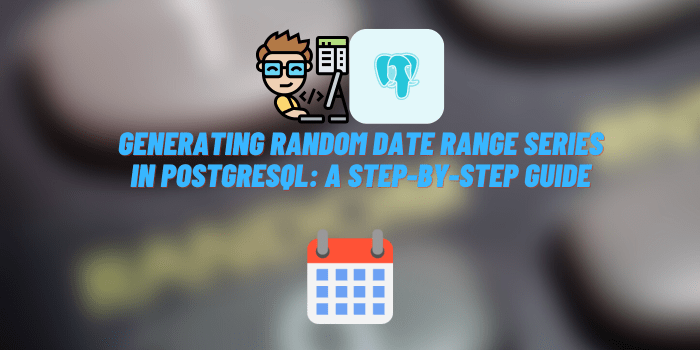Generating Random Date Range Series in PostgreSQL: A Step-by-Step Guide
The purpose of this blog post is to provide a detailed and comprehensive guide on how to generate random date range series in PostgreSQL. This process is crucial for creating realistic test data, simulating various scenarios, and stress-testing database systems. By generating and customizing date range series, database professionals can validate database performance, functionality, and integrity under different conditions. This guide will cover the importance of date range series, the use of Data Generator in dbForge Studio for PostgreSQL, and the step-by-step process for generating and customizing these series. Whether you are an experienced database professional or new to PostgreSQL, this guide will equip you with the knowledge and skills to generate random date range series effectively and efficiently.
What is Date Range Series in PostgreSQL?

A date range series in PostgreSQL is a sequence of dates that spans a specific period. It’s a powerful feature that allows you to represent and manipulate sets of timestamps. The series can be continuous (every day within a range) or discrete (e.g., every Monday within a range), depending on the requirements of your database system.
The importance of date range series in PostgreSQL cannot be overstated. They are essential in various scenarios where time-bound data is involved. For instance, they are used in scheduling applications to block out periods of time, in financial applications to represent fiscal quarters, or in project management tools to track project timelines.
Moreover, date range series can significantly simplify queries that involve periods of time. For example, you can easily find all entries that overlap with a given period, or entries that occur entirely within a specified period.
In essence, date range series in PostgreSQL provide a flexible and efficient way to work with time-bound data, making them an invaluable tool in the arsenal of any PostgreSQL user.
Pre-requisites for Generating Date Range Series
Before you start generating date range series in PostgreSQL, there are a few pre-requisites that you need to fulfill:
Setting Up the PostgreSQL Environment
- PostgreSQL Installation: You need to have PostgreSQL installed on your system. You can download it from the official PostgreSQL website.
- dbForge Studio for PostgreSQL: This tool will be used to generate the date range series. You can download it from the official Devart website.
Once you have these tools installed and set up, and you’re comfortable with the basics of PostgreSQL and SQL, you’re ready to start generating date range series in PostgreSQL.
Introduction to dbForge Studio for PostgreSQL
dbForge Studio for PostgreSQL is a comprehensive and powerful PostgreSQL GUI client designed to enhance and streamline your SQL coding, data editing, reporting, and overall database management tasks. It is a cross-platform tool compatible with Windows, Linux, and macOS, providing a user-friendly interface for developing and managing PostgreSQL databases.
One of the key features of dbForge Studio for PostgreSQL is the Data Generator. This feature is designed to create massive volumes of meaningful, realistic test data. It includes a large collection of predefined data generators with customizable configuration options, allowing you to populate database tables with random data.
When it comes to generating random date range series, Data Generator proves to be an invaluable tool. It offers predefined date generators that you can configure according to your specific needs. You can generate dates within a specified timeframe, set the values to be unique, include or exclude null values, and choose the value distribution mode.
In essence, dbForge Studio for PostgreSQL, with its Data Generator feature, provides a robust and efficient solution for generating random date range series, thereby enhancing your database testing and development processes.
Generating Random Date Range Series
Generating random date range series involves creating a sequence of dates that spans a specific period. This can be done efficiently using the Data Generator feature of dbForge Studio for PostgreSQL. Here’s a step-by-step guide on how to generate random date range series:
Step 1: Automatic Generator Selection
The Data Generator tool automatically chooses a generator for each column based on the table name, column name, data type, and length. It assigns a default data generator. If you want to set another generator, you can select it from the Generator dropdown.
Step 2: Fill Settings
In this group of options, you can:
- Set values to be unique
- Include NULL values and specify their proportion in the generated dataset
- Include empty values and specify their proportion in the generated dataset
- Exclude values and specify their proportion in the generated dataset
- Set up options specific to the selected data generator
The settings may vary depending on the table name, column name, data type, and length. Foreign keys are automatically assigned with the Foreign Key generator.
Step 3: Value Distribution Mode
Options in this section define how the randomly generated data will be distributed. They may vary depending on the column data type, column name, etc. Here are some examples of the Value distribution mode group of options layout:
- Basic Distribution Mode Options: These options are present in most cases. You can distribute values as follows:
Randomly by timestamp
Randomly by seed (you can specify the seed)
- Options to Configure Values Repetition: In this layout available for some columns with an int datatype, besides the basic options, you can select to distribute values sequentially and specify the number of times a value can be repeated in a generated dataset.
- Options to Specify the Increment Value for Sequential Distribution: The layout is available for some columns with datetime and tinyint datatypes, besides the basic options. It allows you to distribute values sequentially and specify the increment value. Depending on the data itself, the increment value can be expressed in days, days and time, or numbers.
- Value Distribution Mode Options to Loop Data: The layout provides the possibility to loop the data to be generated. To do this, select the Loop data checkbox.
By following these steps, you can generate a random date range series in PostgreSQL using the Data Generator feature of dbForge Studio.
Best Practices for Generating Random Date Range Series
Generating random date range series in PostgreSQL can be a straightforward process, especially when using tools like dbForge Data Generator. However, to ensure the most effective and efficient generation, here are some best practices and tips to consider:
- Understand Your Data: Before generating random date ranges, it’s crucial to understand the nature of your data. What is the typical date range you’re dealing with? What are the minimum and maximum values? This understanding will help you generate more realistic and useful test data.
- Use Appropriate Distribution Modes: Data Generator offers several distribution modes. Choose the one that best fits your needs. For example, if you want your dates to be evenly distributed, you might choose a random distribution. If you want them to follow a specific pattern, a sequential distribution might be more appropriate.
- Consider Data Integrity: If your date ranges are linked to other data in your database (e.g., through foreign keys), ensure that the generated data maintains these relationships. dbForge Data Generator automatically assigns the Foreign Key generator to foreign keys, helping maintain data integrity.
- Use Custom Generators When Needed: While Data Generator provides a wide range of predefined generators, there might be cases where you need a specific pattern that isn’t covered. In such cases, don’t hesitate to create and use your own custom generators.
- Test Your Data: After generating your random date range series, use it in your testing environment and see how your database system performs. This will give you insights into whether the generated data is meeting your testing needs and whether you need to adjust your data generation process.
- Iterate and Improve: Data generation is often an iterative process. You might not get the perfect set of test data on your first try. Use each iteration as an opportunity to refine your data generation process, making it better each time.
By following these best practices, you can ensure that you’re generating random date range series in PostgreSQL effectively and efficiently.
Summary
In conclusion, this blog post has provided a comprehensive guide on generating random date range series in PostgreSQL using Data Generator. We’ve explored the importance of date range series, the process of setting up the PostgreSQL environment, and the step-by-step guide on how to generate and customize random date range series. We also delved into the various options available in the Data Generator tool, and shared some best practices for generating random date range series.
The ease and efficiency of dbForge Data Generator make it an invaluable tool for any PostgreSQL user. Whether you’re a seasoned database professional or a beginner, this guide should equip you with the knowledge and skills to generate random date range series effectively and efficiently. Remember, generating realistic test data is a crucial part of database development and testing, and dbForge Data Generator is here to make that process as seamless as possible.






